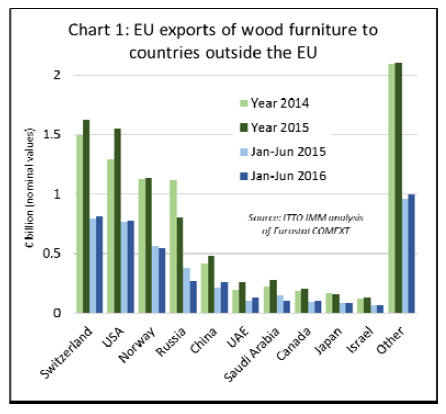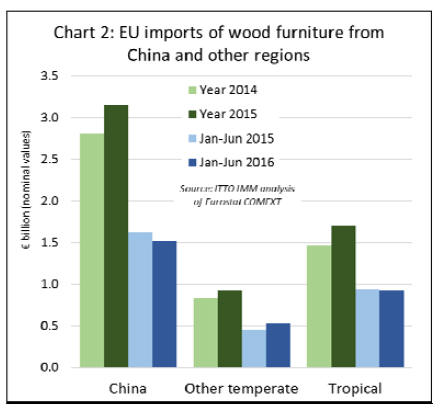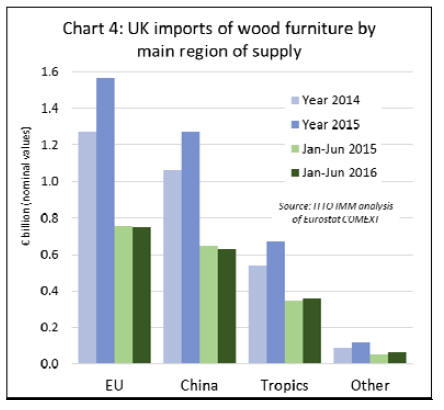|
Report from
Europe
Asian wooden furniture manufacturers losing share in
European market
There was a robust rebound in EU wooden furniture
production and trade in 2014 and 2015. As noted in earlier
ITTO reports, wooden furniture production value in the
EU (excluding kitchen furniture) was euro 31.15 billion in
2015, 4.4% more than 2014 and nearly 9% up on 2013,
with gains made in all the main EU manufacturing
countries
EU imports of wooden furniture from outside the EU were
worth euro 5.73 billion in 2015, 13% more than the
previous year and 25% up on 2013. EU exports of wooden
furniture rose to euro 8.73 billion in 2015, up 3.5% from
2014 and 6% more than in 2009
While no EU furniture production data for 2016 has yet
been published, early signs are that production has
continued to rise this year even while external trade with
non-EU countries has declined. In other words, European
manufacturers are taking a larger share of the internal EU
market in 2016, squeezing out overseas competitors at
home as their efforts to expand sales to non-EU countries
are beginning stall.
Eurostat data shows that the value of wooden furniture
exports by EU countries to other countries within the EU
was euro 8.16 billion in the first half of 2016, 7.3% more
than the same period in 2015. In contrast, the value of
exports to countries outside the EU declined 1% to euro
4.16 billion in the first half of 2016.
The slowdown in EU exports this year is mainly due to a
30% decline in exports to Russia. EU exports to other
countries continue to rise (Chart 1).

Meanwhile external suppliers of wood furniture,
particularly in the tropics, seem to be struggling in what
has become an extremely competitive market. The EU
imported wooden furniture with a total value of euro 2.97
billion in the first six months of 2016, 2% less than the
same period in 2015.
After making significant gains in the EU market in 2015,
EU wooden furniture imports from China and tropical
countries have slipped back this year. In the first six
months of 2016, import value from China declined 7% to
euro 1.51 billion and import value from tropical countries
declined 1% to euro 930 million.
However, EU import value from non-EU temperate
countries increased by 16% to euro 528 million, with
particularly large gains by Turkey, Bosnia and Serbia
(Chart 2).

EU import value of wooden furniture declined from all of
the largest South East Asian suppliers in the first six
months of 2016.
The value of EU import from Vietnan declined by 1.5% to
euro 416 million, by 3.1% from Indonesia to euro 176
million, by 5.2% from Malaysia to euro 100 million, and
by 8.8% from Thailand to euro 34 million.
However, there were gains in imports from India (+7% to
euro87 million) and Brazil (+7% to euro 63 million).
(Chart 3).

Overall, the signs are that, unlike in North America,
domestic manufacturers are maintaining and even
extending their domination of the European wooden
furniture market.
There are many reasons for this. An obvious short term
factor is weakening of European currencies in the last 2
years 每 particularly the UK pound since Brexit - against
the dollar and Chinese yuan.
More enduring factors include: the relative high degree of
fragmentation in the European retailing sector 每 which
greatly complicates market access for overseas suppliers;
the underlying strength of European furniture
manufacturers and their brands in terms of innovation and
design; the obstacles to overseas suppliers complying with
complex EU technical and environmental standards; and
the expansion of furniture manufacturing in Eastern
Europe, a location which combines ready access to raw
materials, relatively cheap labour, and the internal EU
market.
While it seems likely that domestic manufacturers will
continue to dominate Europe*s wooden furniture market in
the years ahead, there are significant changes underway
which are altering the terms of trade. While some changes
are likely to create new obstacles for external suppliers,
others may provide opportunities.
Two factors are particularly significant and explored in the
following sections: the decision of the UK to leave the EU,
so-called Brexit; and the strategy of IKEA, already a
dominant force in the European market place, to increase
their market share through a strategic focus on
※sustainability§ and all that implies for product design,
material procurement, energy efficiency and waste
management.
Brexit: far-reaching consequences for EU wooden
furniture market
Brexit is particularly significant for the wooden furniture
sector as the UK is the largest single EU destination for
this commodity imported from outside the EU. In 2015,
the UK accounted for 36% of all EU imports of wooden
furniture from outside the single market.
This is due to the relatively high degree of consolidation in
the UK*s furniture retailing sector compared to other EU
countries, and the UK*s relatively high level of openness
to foreign trade and products, comparatively small
domestic furniture sector, and longer distances from the
heartland of EU furniture manufacturing in Italy, Germany
and Poland.
Fears of economic fallout from Brexit have led to an
immediate and large devaluation of the British pound
against other currencies. Throughout October, the pound
has been trading at around US$1.22 against the dollar, the
lowest level for 31 years and 18% less than just before the
Brexit vote.
At times during the month the pound also dropped below
the psychologically important euro 1.10 level against the
euro, its lowest level since March 2010 and 15% less than
before the vote.
After a year of strong growth in 2015, the UK*s imports of
wooden furniture had levelled off at the higher level in the
first half of 2016, prior to the Brexit vote.
UK imports from other EU countries and from China had
declined slightly during this period, but were continuing to
grow slowly from the main tropical suppliers including
Vietnam, Malaysia, Brazil and Indonesia (Chart 4).

The impact of Brexit on UK high street retailers in the
immediate aftermath of the Brexit vote seems to have been
muted. The British Retail Consortium (BRC) reports no
discernible impact on retail spending and shop prices
stemming from the EU vote. The first three months after
the referendum saw continuation of a two-year downward
trend in overall retail sales growth.
The one per cent year on year growth in the three months
to September was below the 1.2% average growth in the
twelve months leading up to the vote. Shop prices remain
firmly in deflationary territory, falling 1.8% year on year
in the three months following the vote.
The latest GDP data supports the general conclusion that
the economy has not yet suffered damage from the Brexit
vote, at least in the short term.
Data from the UK Office of National Statistics shows that
the economy grew by 0.5% in the three months to
September, slower than the 0.7% growth achieved in the
previous quarter but stronger than 0.4% growth in the first
quarter.
Annualised growth is currently at 2.3%, amongst the
highest of rich western economies this year. The IMF now
predicts that the UK will be the fastest growing of the G7
leading industrial countries in 2016.
However, the future implications of Brexit for the UK and
the wider EU market for wooden furniture remain very
uncertain.
Although some importers and retailers have been able to
protect themselves in the short term through smart
procurement and forward currency purchases, the pound*s
devaluation is likely to have dampened UK imports of
wooden furniture and other timber products over the
summer months and will continue to act as a drag in the
months ahead.
At some point in the near future, probably early in 2017, it
is widely expected that the pound*s devaluation will begin
to feed through into higher retail prices and slower sales.
Much press coverage on longer term impacts of Brexit
emphasises the downside, notably uncertainty created for
business investment and consumers, the potential for new
tariff and non-tariff barriers in trade with the UK, and the
possibility of rising labour costs if more stringent controls
are imposed on immigration.
None of this should be under-estimated, and politicians in
both the UK and EU face a considerable challenge to
reach an agreement that limits the economic and political
damage.
But expectations in the British retailing community (BRC)
are not entirely negative. This is well illustrated in the
speech by Richard Baker, the BRC Chairman, at an
October meeting of major UK retailers to discuss their
response to Brexit.
Baker was realistic about the challenges of greater
uncertainty, the weaker pound, and tighter controls on
immigration. He observed that a huge proportion of the
goods sold in the UK are sourced from outside the
country, with the EU being by far the single biggest part of
this trade.
There is no clarity at all on how much customs duty will
have to be paid on a huge range of items, both from within
and outside the EU, after Brexit.
However, Baker also noted that ※in my view there is good
reason to believe that smaller, more agile government that
is wholly focused on the needs of Britain has a good
chance of being more successful than one that must
endeavour to satisfy 28 member states and balance their
frequently conflicting agendas§.
Baker also wondered whether ※there is in fact potential for
reduced costs of trading§, speculating that there may well
be opportunities to reduce the burden on UK businesses
currently imposed by the EU through rules on competition
and state aid, environmental protection, workers* rights,
consumer protection and information, health and safety,
data protection, food and other product safety, and so on.
Under the terms of the Great Repeal Bill announced by the
UK Prime Minister in early October, the UK Government
plans to adopt EU legislation wholesale. However, once
the UK exits the EU, there will be a lengthy period of
national consultation when the UK government, guided by
the electorate, decides which rules to repeal, amend or
retain.
Baker indicated that during this period, the BRC ※will be
campaigning for an outcome that enables retailers to offer
great choice and value to their customers by ensuring
access to quality, responsibly-sourced, safe products from
all around the world, free of unnecessary costs and
charges§. Specifically, the BRC will aim to ※ensure that
there are no new tariffs and that the costs of bureaucracy
do not increase§.
Baker noted that that the UK retailer sector is the UK*s
biggest importer and pays billions of pounds each year in
customs duties. It therefore has a considerable stake in
ensuring a favourable outcome.
He noted that ※one BRC member has calculated that the
customs bill could quadruple without a trade deal with the
EU and if the UK loses its privileged trading status with
other countries. Any significant increase in tariffs will
inevitably find its way into shelf prices§.
On the other hand, according to Baker, there may be
opportunities to reduce tariffs where they currently exist.
There may be potential, for example ※for an extension to
the Generalised Scheme of Preferences to allow more
goods from developing countries to enter the UK free of
duty. This would be good for shoppers, good for retailers
and great for the UK*s commitment to a strong
international development agenda§.
It should be said that tariffs are not a particularly critical
issue for external suppliers of wooden furniture into the
EU. EU import tariffs are already zero on all wooden
furniture with the exception of components and kitchen
furniture which are subject to 2.7% tariff.
However, some suppliers of tropical wood would benefit
from a reduction of tariffs or extension of the GSP
framework by the UK. Tariffs of 4% to 5% currently apply
to planed, sanded and finger-jointed sawn tropical timber.
Hardwood veneers and plywood also attract tariffs of
between 3% and 10%.
Baker*s comments also show that UK businesses are not
just looking to minimise the damage from Brexit, or
waiting passively for politicians to come to terms, but are
looking creatively at the new opportunities that may arise
from Brexit.
If there is a so-called ※hard Brexit§ in which the UK fails
to reach agreement with the rest of the EU and withdraws
or is ejected from the single market 每 an event which
could occur as early as 2019 - there will be severe
economic fallout in the UK and, to some extent, other EU
countries.
But UK businesses would then have a very strong
incentive to expand trade with countries outside the EU.
This may be particularly significant for suppliers of
wooden furniture in the tropics whose main competitors in
the UK market are manufacturers located in the EU.
Impact of IKEA*s drive to expand market share
The continuing expansion of IKEA, the world*s largest
furniture company, is another factor driving change in the
EU market for wood furniture. In 2015, IKEA*s sales
increased by 11.2 % to euro 31.9 billion and the company
booked a net profit of euro 3.5 billion, 5.5% more than the
previous year.
Growth was well distributed across IKEA*s markets and
sales were highest in Germany, the US, France, the UK
and Italy.
At the end of the 2015 financial year, IKEA boasted 328
stores in 28 countries, 27 Trading Service Offices in 23
countries, 48 distribution centres in 17 countries, and 43
IKEA industry production units in 11 countries.
Much recent expansion has been in other regions, notably
in South Korea and India, but the company is still heavily
oriented towards Europe. Europe accounts for 229 Stores,
19 distribution centres, and 34 IKEA industry production
units.
Of IKEA*s purchases of home furnishing articles from
suppliers 每 both the company*s own industry production
units and external suppliers - 60% of value derives from
Europe, 35% from Asia, 3% from North America, 2%
from Russia and 1% from South America.
In terms of countries, China is now the largest single
supplier to IKEA, accounting for 25% of purchases,
followed by Poland (19%), Italy (8%), Sweden (5%) and
Lithuania (5%).
IKEA is the largest single buyer of wood material in
Europe, probably in the world. The company consumed
16.2 million cubic meters of wood (roundwood
equivalent) in the 2015 financial year, up 4% compared to
the previous year.
Around 60% of this comprised solid wood and 40% board
products. If paper and packaging is included, the company
is estimated to need close to 20 million cubic meters of
wood fibre every year.
Most of IKEA*s wood supply derives from Europe, the
largest suppliers being Poland (around a quarter),
Lithuania (7.5%), Russia (7%), and Sweden (6.5%).
Swedwood, an IKEA subsidiary, handles production of all
wood based furniture.
To date, IKEA has been almost entirely reliant on wood
owned and managed by other companies, but recently it
has bought a few relatively small forest areas in Romania
and the Baltic States in order to secure long-term access to
sustainably managed wood at affordable prices.
IKEA is not a major user of tropical wood and, in fact, has
played a leading role over the last quarter century to drive
European consumers towards the clean and light
&Scandinavian look*, heavily dependent on softwoods and
temperate hardwoods.
Due to the company*s very high profile, IKEA is
inevitably a principal target for negative environmental
campaigns whenever a tropical wood appears in any
product line.
One environmental group in Germany, went so far as to
test a wide range of IKEA products for tropical wood
content and launched a highly critical public campaign
following their identification of tropical wood fibre in
paper supplied by the company.
Nevertheless, IKEA has not excluded tropical wood from
their product range. The company*s Skogsta product line
is made of acacia which, in line with their broader
environmental strategy, seeks to maximise utilisation of
the material.
The product line shows off the natural colour variation in
the wood, utilising both the light blond and dark shades of
timber.
While IKEA does not exclude use of tropical wood in its
product lines, the company is ratcheting up the
procurement requirements imposed on all suppliers. Since
2000, IKEA has operated a supplier code of conduct for
purchasing all products, materials and services referred to
internally as IWAY. It sets out our minimum requirements
for suppliers, covering environment, social and working
conditions and it is a pre-condition for doing business with
the company.
Due to the volumes involved, IKEA*s timber procurement
policy has the power to drive wider changes in the wood
supply chain. In practice, IKEA have been a major factor
behind the moves to reduce the length of wooden furniture
supply chains, increase dependence of the European
wooden furniture sector on local wood supplies, and to
discourage a movement by manufacturers to other regions.
|